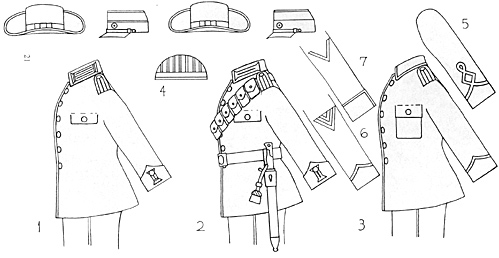Figure 1 - Protective Force Officer (rank of Second Lieutenant), 1894. Light gray coat with cornflower blue collar, cuffs, and piping down the leading edge, silver buttons, silver shoulder straps with red and black lines, silver lace on collar and cuffs. Light gray trousers with cornflower blue piping down the outer seam of each leg. Light gray cap, cornflower blue band and piping around the top of the crown, black-white-red national cockade narrow silver braid along the top edge of the cap band, black peak and chinstrap. (A brown leather belt was worn in the field.)
Parade Dress - silver aiguillette from left shoulder, woven silver sash with two stripes of black and one of red, with a bow and two large silver tassels on the left hip (worn up to 1895, it was succeeded by the woven silver waistbelt), light gray hat and band, sword with golden hilt and white metal scabbard, silver sword knot with red stripe in center of strap.
Figure 2 - Protective Force Trooper, 1894. Light gray coat with cornflower blue collar, cuffs and piping down the leading edge, silver buttons, shoulder cords of black-white-red mix, white lace with red stripe in center on the collar and cuffs. Light gray trousers with cornflower blue piping. Light gray cap as (1) but without silver braid. Natural leather bandolier. Natural leather belt, yellow metal buckle with circular white metal center, natural leather bayonet frog, black scabbard witth white metal tip, steel hilt with brown grip, company bayonet knot. The bayonet knot or troddel as it was known, was divided into several parts—the strap, top, stock, crown, and tassel. The one here was illustrated in the original plate as white with red top and crown. (I believe the colors ran, 1st - all white, 2nd - white with red top and crown, 3rd - white with yellow top and crown, 4th - white with cornflower blue top and crown.)
Parade Dress - white aiguillette from left shoulder, light gray hat with cornflower blue band, edge of brim bound with cornflower blue trim, same gear.
Figure 3 - Protective Force Trooper, brown drill coat, 1894. Dark khaki coat with cornflower blue piping on the collar, cuffs, and leading edge, silver buttons, shoulder cords of black-white-red mix. Dark khaki trousers with cornflower blue piping. Cap, belt, and gear as (2).
Figure 4 - Musicians swallows nest. Wide white braid on cornflower blue base. One would be worn on each shoulder of (2) or (3) up to 1896.
Figure 5 - Officer's sleeve insignia of cornflower blue braid for the brown drill coat. Worn on both sleeves up to 1896.
Figure 6 - Cornflower blue grade chevrons for the rank of Feldwebel. (Sergeant had two chevrons, Unteroffizier had one). Worn on the left sleeve of the brown drill coat up to 1896.
Figure 7 - Medical Service Unteroffizier sleeve insignia for the brown drill coat up to 1896. Single red chevron on the left sleeve, red piping on the cuffs. (Paymaster-Aspirant insignia was illustrated with the dark blue chevrons on the left sleeve. The cuffs were trimmed in the same way, only with white piping.)
The text appears to indicate that brown leather leggings with buckles down the side were worn at this time.
Drawings after illustration, Uniformbogen Nr. 21, Schutztruppe fur Deutsch-Sudwestafrica 1889-1915, H. Knotel/Hans M. Brauer.

German Colonial Uniforms in South West Africa
- Imperial Commissioner's Unit
Imperial Protective Force (Schutztruppe) 1894
Protective Force (Schutztruppe) 2d Lieut., Campaign Dress 1904-1908
Volunteer Corps 1914-1915
Schutztruppe 1896-1915
Police Sergeant-Major 1907-1915
Back to The Heliograph's German Colonial Military Uniforms: Africa Table of Contents
Back to The Heliograph List of Issues
Back to Master Magazine List
© Copyright 2003 by Richard Brooks.
This article appears in MagWeb.com (Magazine Web) on the Internet World Wide Web.
Other articles from military history and related magazines are available at http://www.magweb.com